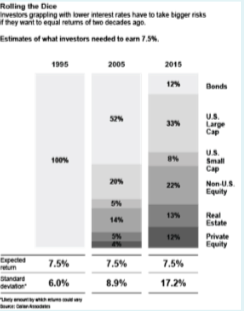A recent study by Callan Associates, Inc. highlights the impact that low interest rates can have on investors achieving their long-term financial goals: According to Callan, in 1995, to obtain a 7.5 percent annual return, investors simply needed to purchase a diversified portfolio of high-quality fixed-income securities, with the likelihood that investment returns would vary by about 6 percent.
Fast-forward to 2015. Callan found that in order to achieve this same 7.5 percent annual return last year, a modern portfolio would require a more complex mix of investment strategies than was needed 20 years ago.
While that modern portfolio would have an allocation to fixed income, it would also include equities, real estate and private equity. And its investment returns? They could vary by more than 17 percent, almost three times the volatility of the fixed-income portfolio of 1995!
Given our expectations that interest rates will remain lower, longer, investors don’t have the luxury of simply waiting for higher interest rates to provide the solution. They need to acknowledge that this low interest-rateenvironment may potentially be maintained far into the future, and develop a plan that recognizes how current economic conditions drive capital-market returns.
The significant decline in global interest rates is having a profound impact on how investors achieve their long-term investment goals.
Certainly it is true that today’s asset allocations are more complex than they were 20 years ago and that investors are likely to notice more volatility in their monthly statements. Moreover, stocks and private equity have the potential to lose capital. However, this can be mitigated if managed correctly.
And although fixed income is likely to have a reduced allocation in today’s portfolio compared with the 1995 portfolio, this asset class continues to have an important role as a diversifier to stocks or alternative investments like private equity.
As the asset-allocation decision becomes more complex, it is important that any recommended allocation be linked to a capital-markets outlook for the next 12-to-36 months. This “base case” investment outlook should be the foundation of a client’s asset allocation, along with a plan to make adjustments based on changes in the capital markets or in the client’s investment objectives.
Patient investors will be rewarded, but it is also important to recognize that when capital markets fluctuate, opportunities are created.
The significant decline in global interest rates is having a profound impact on how investors achieve their long-term investment goals. Those investors who recognize these current conditions and their impact will be in the best position to meet their financial objectives.
Information expressed herein is strictly the opinion of Kayne Anderson Rudnick and is provided for discussion purposes only. This report should not be considered a recommendation or solicitation to purchase securities. Pastperformance is no guarantee of future results.
This article was originally published in the October/November2016 issue of Worth.

















